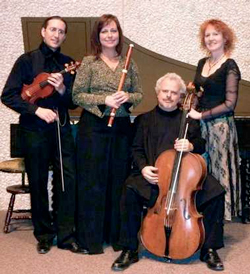by Guytano Parks

The principal players of Apollo’s Fire were of one mind and spirit and their rapport was apparent as they opened the program with Telemann’s Paris Quartet No. 12 in e minor. Phrases were delivered sensitively with nuance and expressive ornamentation. The interplay between the performers in sequential sections and the echoing of phrases in others sounded personal, much like a conversation. Improvisatory writing in the Prelude plus sections of lyricism within the other movements nicely offset the lively nature of this work.
The solo cello suites by Bach are among the most sublime of artistic creations. Perhaps the most intimate work on this program was the Suite No. 2 in D minor.Mr. Schiffer made the music his own, playing with reverence and nobility. In the Prelude and Allemande, he deftly maintained legato lines while expressively leaping between high and low registers, creating a harmonic and chordal structure through implication.
The Courante moved along at a nice pace while the Sarabande was stately in its expansiveness, allowing time for the music to resonate then fade away at the end. The Menuets I & II were played with a proper, lighter feel before the spirited Gigue, with its prominent upbeats, convivially ended the suite.
Bach’s Flute Sonata in e minor is written in the traditional slow-fast-slow-fast four-movement form. Performing on the traverso, a wooden Baroque flute with a sweet and mellow tone similar to that of a recorder, Kathie Stewart was joined in this masterful work by Sorrell on harpsichord and Schiffer on cello. Poignant two-note slurs at the ends of phrases in the Adagio were distinctively placed. The balance between these seasoned musicians was superb, making for clear and thoughtful expressiveness at all times.
Running passages by the flute against strong, rhythmic chords by the harpsichord and cello in the first Allegro were played with precision and exuberance. After the harpsichord’s introduction set the mood for the flute’s heavenly entrance, lyrical lines blossomed organically as the two phrased and breathed as one in the third movement Andante. The Allegro was off and running, full of rapid passages, emphatic repeated notes, strong downbeats and loads of details of articulation and dynamics. All three musicians relished in their displays of virtuosity in this fiery finale.
In keeping with the theme of intimacy, another solo piece was performed; this time on violin. Although it may be described as celestial, Bach’s Ciaccona from the Violin Partita No. 2 in d minor is much more extroverted than the cello suite Schiffer played. Considered to be one of the most technically and musically demanding works for violin, it is a set of variations over a repeating ground-base pattern, much like a passacaglia. It is in three sections with the middle being in a major key.
Olivier Brault gave a powerful and spiritual performance which pulsed with a solid rhythmic sense. The violinist’s bowing technique is quite impressive, enabling him to play with abandon within its underlying formal structure. Intonation remained secure as he soared heavenward with a dizzying cascade of notes while full-throated low pitches rang out with penetrating tone. This performance can serve as testament to the capabilities of period instruments, and may lay to rest the notion that such instruments fail to deliver enough variety of tone and color.
Speaking to the audience from the stage, Jeanette Sorrell described Telemann’s Paris Quartet No. 1 in G major as having “laughter and virtuosity.” The first movement begins Grave — like an ingratiating and cordial first meeting — then launches into an Allegro, teeming with fun and frolic. As the pattern repeated, Sorrell, Brault, Stewart and Schiffer played with marvelous rapport, maintaining the standards for which the ensemble is noted, never missing a beat nor an opportunity for stylish nuance.
Menacing diminished-seventh chords, variations between legato and staccato articulations plus dramatic dotted rhythms distinguished the second movement. The concluding Allegro again found the ensemble to be in top form, paying meticulous attention to the many details in the writing as contrasts between light and dark, more dramatic dotted rhythms and striking sustained notes within sequences were brought to the fore.
Published on ClevelandClassical.com March 17, 2013
Click here for a printable version of this article.



